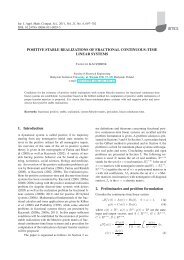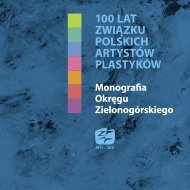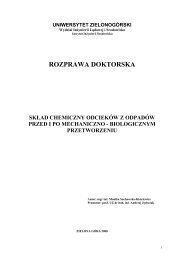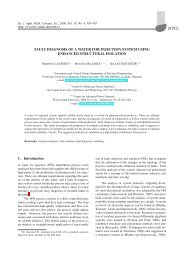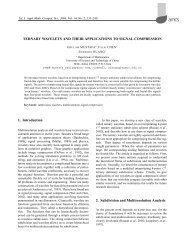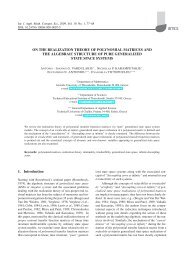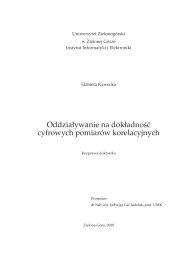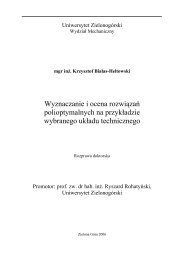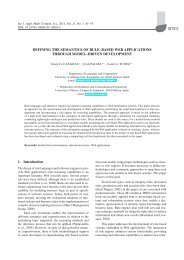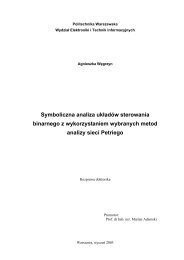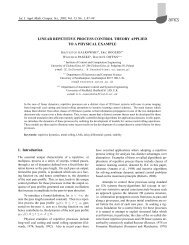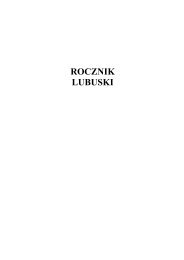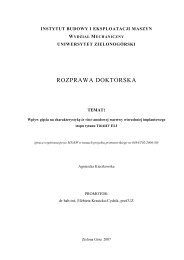NOISE EFFECTS IN THE QUANTUM SEARCH ALGORITHM FROM ...
NOISE EFFECTS IN THE QUANTUM SEARCH ALGORITHM FROM ...
NOISE EFFECTS IN THE QUANTUM SEARCH ALGORITHM FROM ...
Create successful ePaper yourself
Turn your PDF publications into a flip-book with our unique Google optimized e-Paper software.
Int. J. Appl. Math. Comput. Sci., 2012, Vol. 22, No. 2, 493–499<br />
DOI: 10.2478/v10006-012-0037-2<br />
<strong>NOISE</strong> <strong>EFFECTS</strong> <strong>IN</strong> <strong>THE</strong> <strong>QUANTUM</strong> <strong>SEARCH</strong> <strong>ALGORITHM</strong> <strong>FROM</strong> <strong>THE</strong><br />
VIEWPO<strong>IN</strong>T OF COMPUTATIONAL COMPLEXITY<br />
PIOTR GAWRON, JERZY KLAMKA, RYSZARD W<strong>IN</strong>IARCZYK<br />
Institute of Theoretical and Applied Informatics<br />
Polish Academy of Sciences, ul. Bałtycka 5, 44-100 Gliwice, Poland<br />
e-mail: gawron@iitis.pl<br />
We analyse the resilience of the quantum search algorithm in the presence of quantum noise modelled as trace preserving<br />
completely positive maps. We study the influence of noise on the computational complexity of the quantum search algorithm.<br />
We show that it is only for small amounts of noise that the quantum search algorithm is still more efficient than any<br />
classical algorithm.<br />
Keywords: quantum algorithms, quantum noise, algorithm complexity.<br />
1. Introduction<br />
It is often said that the strength of quantum computation<br />
lies in the phenomena of quantum superposition and quantum<br />
entanglement. These features of quantum computation<br />
allow performing the computation on all possible<br />
inputs that fit the quantum register. One of the greatest<br />
achievements in the theory of quantum algorithms is the<br />
quantum search algorithm introduced by Grover. A detailed<br />
description of this algorithm can be found in the<br />
works of Grover (1996; 1997; 1998) and Bugajski (2001).<br />
Any physical implementation of a quantum computer<br />
will be error-prone because of the interaction of the computing<br />
device with the environment. In this paper we investigate<br />
the resilience of Grover’s algorithm in the presence<br />
of quantum noise. We use the language of density<br />
matrices and quantum channels. Our goal is to find the<br />
maximal amount of noise for which the quantum algorithm<br />
is better, in terms of the mean number of operations,<br />
than the classical algorithm. We aim to achieve this objective<br />
by considering some classes of quantum channels<br />
modelling environmentally induced noise.<br />
The paper is organised as follows. In Section 2 we<br />
provide a short review of the subject. In Section 3 we<br />
describe the formalism of quantum information theory. In<br />
Section 4 we present the quantum search algorithm. In<br />
Section 5 we introduce the noise model we have applied<br />
to the system. In Section 6 we analyse the results, and<br />
finally in Section 7 we present some conclusions.<br />
2. Review of existing work<br />
The problem of the influence of noise on the quantum<br />
search algorithm has been extensively studied by various<br />
researchers. Barnes and Warren (1999) discuss the<br />
influence of the classical field upon a quantum system<br />
implementing Grover’s algorithm. Pablo-Norman and<br />
Ruiz-Altaba (1999) pose a question similar to ours, but<br />
use a Gaussian noise model, which in their case is not<br />
described in the language of quantum channels. Long<br />
et al. (2000) analyse how imperfections in realizations of<br />
quantum gates influence the probability of the success of<br />
the quantum search algorithm. Konstadakis and Ellinas<br />
(2001) analyse the behaviour of the quantum search algorithm<br />
implemented with the use of noisy π/4 rotation<br />
gates.<br />
The effect of unitary noise on the quantum search algorithm<br />
is studied by Shapira et al. (2003). Shenvi et al.<br />
(2003) examine the robustness of Grover’s search algorithm<br />
to a random phase error in the oracle and analyse<br />
the complexity of the search process. Azuma (2005) studies<br />
decoherence in Grover’s quantum search algorithm<br />
using a perturbation method. Zhirov and Shepelyansky<br />
(2006) use the methods of quantum trajectories to study<br />
the effects of dissipative decoherence on the accuracy of<br />
Grover’s quantum search algorithm. Salas (2008) numerically<br />
simulates Grover’s algorithm introducing random<br />
errors of two types: one- and two-qubit gate errors and<br />
memory ones.
494 P. Gawron et al.<br />
3. Formalism of quantum information<br />
3.1. Dirac notation. Throughout this paper we use the<br />
Dirac notation. The symbol |ψ〉 denotes a complex column<br />
vector, 〈ψ| denotes the row vector dual to |ψ〉. The<br />
scalar product of vectors |ψ〉, |φ〉 is denoted by 〈ψ|φ〉. The<br />
outer product of these vectors is denoted by |φ〉〈ψ|. Vectors<br />
are labelled in a natural way: |0〉 := ( 1 0 ), |1〉 := ( 0 1 ).<br />
Notation such as |φψ〉 denotes the tensor product of vectors<br />
and is equivalent to |φ〉⊗|ψ〉.<br />
and the partial trace with respect to system A reads<br />
tr A (ρ AB )= ∑ m<br />
ρmμ<br />
mν = ρB .<br />
Given the state of the composed system ρ AB ,the<br />
state of subsystems can by found by taking the partial<br />
trace of ρ AB with respect to one of the subsystems. It<br />
should be noted that tracing-out is not a reversible operation,<br />
so, in a general case,<br />
3.2. Density operators. The most general state of<br />
a quantum system is described by a density operator. In<br />
quantum mechanics a density operator ρ is defined as a<br />
Hermitian (ρ = ρ † ) positive semi-definite (ρ ≥ 0) trace<br />
one (tr(ρ) =1) operator. When a basis is fixed, the density<br />
operator can be written in the form of a matrix. Diagonal<br />
density matrices can be identified with probability<br />
distributions, and therefore this formalism is a natural extension<br />
of probability theory.<br />
Density operators are usually called quantum states.<br />
The set of quantum states is convex (Bengtsson and Życzkowski,<br />
2006), and its boundary consists of pure states<br />
which in matrix terms are rank one projectors. Convex<br />
combinations of pure states lie inside the set and are called<br />
mixed states.<br />
3.2.1. Entanglement. Entanglement is one of the most<br />
important phenomena in quantum information theory. We<br />
say that a state ρ is separable iff it can be written in the<br />
following form:<br />
ρ =<br />
M∑<br />
q i ρ A i ⊗ ρ B i , (1)<br />
i=1<br />
where q i > 0 and ∑ M<br />
i=1 q i =1. A state that is not separable<br />
is called entangled. It is an open problem of great<br />
importance and under investigation to decide if a given<br />
quantum state is entangled or not.<br />
3.2.2. Subsystems. Given two states ρ A , ρ B of two<br />
systems A and B, the product state ρ AB of the composed<br />
system is obtained by taking the Kronecker product of the<br />
states, i.e., ρ AB = ρ A ⊗ ρ B .<br />
Let [ρ AB ] kl be a matrix representing a quantum system<br />
composed of two subsystems of dimensions M and<br />
N. We want to index the matrix elements of ρ using<br />
two double indices [ρ AB ]mμ, so that Latin indices correspond<br />
to the system A and Greek indices correspond<br />
nν<br />
to the system B. The relation between the indices is<br />
k =(m − 1)N + μ, l =(n − 1)N + ν. The partial<br />
trace with respect to system B reads<br />
tr B (ρ AB )= ∑ μ<br />
ρmμ<br />
nμ = ρA ,<br />
ρ AB ≠tr A (ρ AB ) ⊗ tr B (ρ AB ). (2)<br />
3.3. Completely Positive Trace-Preserving (CPTP)<br />
maps. We say that an operation is physical if it transforms<br />
density operators into density operators. Additionally,<br />
we assume that physical operations are linear. Therefore,<br />
in order for an operation Φ(·) to be physical, it has<br />
to fulfil the following set of conditions:<br />
(i) For any operator ρ its image under operation Φ has to<br />
have its trace and positivity preserved, i.e., if tr(ρ) =<br />
1,ρ ≥ 0,ρ = ρ † , then tr(Φ(ρ)) = 1, Φ(ρ) ≥<br />
0, Φ(ρ) =Φ(ρ) † .<br />
(ii) The operator Φ has to be linear:<br />
( ) ∑<br />
Φ p i ρ i = ∑ p i Φ(ρ i ) . (3)<br />
i<br />
i<br />
(iii) The extension of the operator Φ to any larger dimension<br />
that acts trivially on the extended system has<br />
to preserve positivity. This feature is called complete<br />
positivity. This means that for all positive semidefinite<br />
ρ, ξ ≥ 0, the following holds:<br />
(Φ ⊗ I dim (ξ) )(ρ ⊗ ξ) =Φ(ρ) ⊗ ξ ≥ 0. (4)<br />
CPTP maps are often called quantum channels.<br />
3.3.1. Kraus form. Any operator Φ that is completely<br />
positive and trace preserving can be expressed in the socalled<br />
Kraus form (Bengtsson and Życzkowski, 2006),<br />
which consists of a finite set {E k } of Kraus operators,<br />
i.e., matrices that fulfil the completeness relation:<br />
∑<br />
k E k † E k = I. The image of the state ρ under the map<br />
Φ is given by<br />
Φ(ρ) = ∑ k<br />
E k ρE k † . (5)<br />
3.4. Measurement. Quantum states cannot be observed<br />
directly. In the literature, two main types of measurements<br />
are considered: von Neumann measurements
Noise effects in the quantum search algorithm from the viewpoint of computational complexity<br />
495<br />
and POVM (Positive Operator Valued Measure) measurements.<br />
In this paper we use only von Neumann measurements,<br />
but for the sake of completeness we also define<br />
POVM measurements.<br />
The mathematical formulation of von Neumann measurement<br />
is given by a map from a set of projection operators<br />
to real numbers.<br />
Let us consider an orthogonal complete set of projection<br />
operators P = {P i } N i=1 and the set of real measurement<br />
outcomes O = {o i } N i=1 . The mapping P → O<br />
is called the von Neumann measurement. Assuming the<br />
system is in the state ρ, the probability p i of measuring<br />
outcome o i is given by the relation p i =tr(P i ρ).<br />
The POVM measurement can be considered a generalisation<br />
of the von Neumann measurement. Let us<br />
take a set of positive operators F = {F i } N i=1 such that<br />
∑ N<br />
i=1 F i = I and the set of real measurement outcomes<br />
O = {o i } N i=1 . The mapping F → O is called the POVM<br />
measurement. Given the system in the state ρ, the probability<br />
p i of measuring the outcome o i isgivenbytherelation<br />
p i =tr(F i ρ).<br />
4. Overview of Grover’s algorithm<br />
Grover’s unordered database search algorithm is one of<br />
the most important quantum algorithms. This is due to<br />
the fact that many algorithmic problems can be reduced to<br />
exhaustive search.<br />
The main idea of the algorithm is to amplify the probability<br />
of the state which represents the sought element.<br />
The algorithm is probabilistic and may fail to return the<br />
proper result. Fortunately, the probability of success is<br />
reasonably high.<br />
4.1. Problem. Let X be a set and let f : X →{0, 1},<br />
such that<br />
{ 1 if x = x0 ,<br />
f(x) =<br />
(6)<br />
0 if x ≠ x 0 ,<br />
x ∈ X, for some marked x 0 ∈ X.<br />
For simplicity, we assume that X is a set of binary<br />
strings of length n. Therefore, |X| = 2 n and<br />
f : {0, 1} n →{0, 1}. We can map the set X to a set<br />
of states over C ⊗2n in a natural way: x ↔|x〉, forming<br />
an a orthogonal, complete set of vectors. The goal of the<br />
algorithm is to find the marked element.<br />
4.2. Algorithm. Grover’s algorithm is composed of<br />
two main procedures: the oracle and diffusion.<br />
With the use of elementary quantum gates the oracle<br />
can be constructed using ancilla |q〉 in the following way:<br />
O|x〉|q〉 = |x〉|q ⊕ f(x)〉, (7)<br />
where ⊕ denotes addition modulo 2. If the register |q〉 is<br />
prepared in the state<br />
|q〉 = H|1〉 = |0〉−|1〉 √ , (8)<br />
2<br />
where H denotes the Hadamard gate, then, by substitution,<br />
Eqn. (7) can be written as<br />
O|x〉 |0〉−|1〉 √<br />
2<br />
By tracing out the ancilla, we obtain<br />
=(−1) f(x) |x〉 |0〉−|1〉 √<br />
2<br />
. (9)<br />
O|x〉 = −(−1) f(x) |x〉. (10)<br />
4.2.2. Diffusion. The operator D rotates any state<br />
around the state<br />
|ψ〉 = √ 1<br />
2∑<br />
n −1<br />
|x〉, (11)<br />
2<br />
n<br />
where D can be written as<br />
x=0<br />
D = −H ⊗n (2|0〉〈0|−I)H ⊗n =2|ψ〉〈ψ|−I. (12)<br />
4.2.3. Initialisation. We begin in the ground state<br />
|0 ...00〉. In the first step of the algorithm we apply the<br />
Hadamard gate H ⊗n to the entire register. This transforms<br />
the initial state into flat superposition of computational<br />
base states:<br />
H ⊗n |0 ...0〉 = √ 1 (|0 ...00〉 + ···+ |1 ...11〉) .<br />
n<br />
(13)<br />
4.2.4. Grover iteration. The core of the algorithm<br />
consists of the applications of the so-called Grover iteration<br />
gate G = D · O. This procedure causes the sought<br />
state to be amplified and other states to be attenuated.<br />
4.2.5. Number of iterations. The application of the<br />
diffusion operator to the base state |x〉 gives<br />
D|x〉 = −|x 0 〉 + 2 ∑<br />
|y〉. (14)<br />
N<br />
The application of this operator on any state gives<br />
y<br />
4.2.1. Oracle. By an oracle we mean a function that<br />
marks one defined element. In the case of Grover’s algorithm,<br />
the marking of the element is done by the negation<br />
of the amplitude of the sought state.<br />
D|x〉 = ∑ α i (−|x〉 + 2 N y ∑ i<br />
y<br />
= ∑ (−α i +2s)|x〉,<br />
i<br />
|y〉)
496 P. Gawron et al.<br />
where<br />
s = 1 ∑<br />
α i . (15)<br />
N<br />
A k-fold application of Grover’s iteration G to the<br />
initial state |s〉 leads to (Bouwmeester et al., 2000; Bugajski,<br />
2001)<br />
G k |s〉 = α k<br />
∑<br />
x≠x 0<br />
|x〉 + β k |x 0 〉, (16)<br />
with real coefficients<br />
1<br />
α k = √ cos (2k +1)θ, β k =sin(2k +1)θ,<br />
N − 1<br />
(17)<br />
where θ is an angle that fulfils the relation<br />
sin(θ) = √ 1 . (18)<br />
N<br />
Therefore the coefficients α k ,β k are periodic functions of<br />
k. After a series of iterations, β k rises. The influence of<br />
the marked state |x 0 〉 on the state of the register results<br />
in the evolution of the initial state |s〉 towards the marked<br />
state.<br />
β k attains its maximum after approximately π 4<br />
√<br />
N<br />
steps. The number of steps needed to transfer the initial<br />
state towards the marked state is of order O( √ N). Inthe<br />
classical case the number of steps is of order O(N).<br />
4.2.6. Measurement. The last step of Grover’s algorithm<br />
is a von Neumann measurement. The probability of<br />
obtaining the proper result is |β k | 2 .<br />
5. Noise model<br />
The above discussion of the quantum search algorithm has<br />
been conducted using the state vector formalism. In order<br />
to incorporate noise into the quantum computation model,<br />
we have to make use of density operators which define the<br />
quantum state in the most general way.<br />
5.1. Quantum noise. Microscopic systems that are<br />
governed by the laws of quantum mechanics are hard to<br />
control and, at the same time, to separate from the environment.<br />
The interaction with the environment introduces<br />
noise into the quantum system. Therefore any future<br />
quantum computer will also be prone to noise.<br />
One-qubit noise. There are several one-parameter families<br />
of one-qubit noisy channels that are typically discussed<br />
in the literature (Nielsen and Chuang, 1999). We<br />
present them briefly below.<br />
Depolarising channel. This is a bi-stochastic channel that<br />
transforms any state into a maximally mixed state with<br />
i<br />
a given probability α. The family of channels can be defined<br />
using a four-element set of Kraus operators<br />
{ √ √ √ √1 α α α − αI,<br />
3 σ x,<br />
3 σ y, z}<br />
3 σ ,<br />
where<br />
[ ]<br />
[ ]<br />
1 0<br />
0 1<br />
I = , σ<br />
0 1<br />
x = ,<br />
1 0<br />
[ ]<br />
[ ]<br />
0 −i<br />
1 0<br />
σ y =<br />
, σ<br />
i 0<br />
z =<br />
0 −1<br />
are Pauli matrices.<br />
Amplitude damping. The amplitude damping channel<br />
transforms |1〉 into |0〉 with a given probability α. The<br />
state |0〉 remains unchanged. The set of Kraus operators<br />
is {[ 1 0<br />
0<br />
√ 1 − α<br />
]<br />
,<br />
[<br />
0<br />
√ α<br />
0 0<br />
]}<br />
.<br />
Phase damping. Phase damping in a quantum phenomenon<br />
describes the loss of quantum information without<br />
the loss of energy. It is described by the following set<br />
of Kraus operators:<br />
{[ ] [ ]}<br />
1<br />
√ 0 0 0<br />
,<br />
0 1 − α 0 √ .<br />
α<br />
Bit flip. The bit flip family of channels is the quantum<br />
version of the classical binary symmetric channel. The<br />
action of the channel might be interpreted in the following<br />
way: it flips the state of a qubit from |0〉 to |1〉 and from |1〉<br />
to |0〉 with probability α. Kraus operators for this family<br />
of channels consist of a matrix proportional to the identity<br />
and a matrix proportional to the negation gate,<br />
{√ √ }<br />
1 − αI, ασx .<br />
Phase flip. The phase flip channel acts similarly to the bit<br />
flip channel with the distinction that a σ z gate is applied<br />
randomly to the qubit<br />
{√ √ }<br />
1 − αI, ασz .<br />
Bit-phase flip. The bit-phase flip channel may be considered<br />
a joint application of bit and phase flip gates to a<br />
qubit. Its Kraus operators are as follows:<br />
{√ √ }<br />
1 − αI, ασy .<br />
In all of the above families of channels, the real parameter<br />
α ∈ [0, 1] can be interpreted as the amount of<br />
noise introduced by the channel.
Noise effects in the quantum search algorithm from the viewpoint of computational complexity<br />
497<br />
|0〉<br />
|0〉<br />
.<br />
|0〉<br />
H ⊗n<br />
Iterate √ N π 4 times<br />
<br />
<br />
<br />
<br />
<br />
<br />
<br />
<br />
<br />
Diffusion<br />
<br />
Oracle<br />
|x〉→(−1) f(x) |x〉 H ⊗n |0〉→|0〉<br />
|x〉→−|x〉 H ⊗n Noise<br />
<br />
ρ t+1=Φ(ρ t) <br />
<br />
forx>0<br />
<br />
<br />
<br />
<br />
<br />
<br />
<br />
<br />
<br />
<br />
<br />
<br />
.<br />
<br />
<br />
Fig. 1. Circuit for Grover’s algorithm extended with a non-unitary noisy channel.<br />
Multiqubit local channels. Our goal is to extend the<br />
noise acting on distinct qubits to the entire registers. We<br />
assume that the appearance of an error on a given qubit is<br />
independent of an error appearing on any other qubits.<br />
In order to apply noise operators to multiple qubits,<br />
we form a new set of Kraus operators acting on a larger<br />
Hilbert space.<br />
We assume that we have the set of n one-qubit Kraus<br />
operators {e k } n k=1 . We construct the new set of nN operators<br />
{E k } nN<br />
k=1<br />
that act on a Hilbert space of dimension<br />
2 N by applying the following formula:<br />
where<br />
{E k } = ⋃ {e i1 ⊗ e i2 ⊗ ...⊗ e iN }, (19)<br />
I<br />
I = {i 1 } n i 1=1 ×{i 2 } n i 2=1 × ...×{i N } n i N =1.<br />
One should note that the extended channel Φ(ρ) =<br />
∑<br />
k E kρE † k<br />
is by definition local (Bengtsson and Życzkowski,<br />
2006).<br />
By applying Eqn. (19) to the sets of operators listed<br />
above, we obtain one-parameter families of local noisy<br />
channels, which we use in further investigations.<br />
5.2. Application of noise to the algorithm. In order to<br />
simulate noisy behaviour of the system implementing the<br />
algorithm, we apply a noisy channel after every Grover<br />
iteration. The evolution of the system is described by<br />
the following procedure, which is graphically depicted in<br />
Fig. 1:<br />
1. Prepare the system in state ρ 0 := |0 ⊗n 〉〈0 ⊗n |.<br />
2. ρ := H ⊗n ρ 0 H ⊗n†<br />
3. ⌊ π 4<br />
√<br />
N⌋ times do:<br />
(a) apply Grover’s iteration ρ := GρG † ,<br />
(b) apply noise ρ := Φ(ρ).<br />
4. Perform an orthogonal measurement in the computational<br />
basis. The probability of finding the sought<br />
element ξ is p = 〈ξ|ρ|ξ〉.<br />
This approach simplifies the physical reality, but it is<br />
sufficient to study the robustness of the algorithm in the<br />
presence of noise. In order to study the discussed problem,<br />
we make use of numerical simulations. Therefore<br />
some simplification is necessary as the size of the problem<br />
grows exponentially fast with the number of qubits.<br />
The tool we use is quantum-octave (Gawron<br />
et al., 2010), a library that contains functions for simulation<br />
and analysis of quantum processes.<br />
In our model we assume that it is easy to verify the<br />
correctness of the quantum search algorithm. It is an<br />
assumption usually made in the complexity analysis of<br />
search algorithms.<br />
6. Analysis of the influence of noise on the<br />
efficiency of the algorithm<br />
An interesting question arises: “What is the maximal<br />
amount of noise for which Grover’s algorithm is more efficient<br />
than any classical search algorithm”<br />
Grover’s algorithm is probabilistic, therefore we cannot<br />
expect to obtain a valid outcome with certainty. We<br />
assume that if the algorithm fails in a given run we will<br />
rerun it. There is a certain number of reruns for which the<br />
quantum algorithm is worse than the classical. We are interested<br />
only in the statistical behaviour of algorithm and<br />
calculate the mean value of repetitions.<br />
Let k = ⌊ N 2 / √ π<br />
4 N⌋ be the maximal number of single<br />
runs of Grover’s algorithm for which quantum search<br />
is faster than the classical one.<br />
We compute the minimal value of success probability<br />
p min of a single run of Grover’s algorithm for which we<br />
obtain a valid result with confidence C,<br />
{<br />
p min =min 1 − (1 − p) k ≥ C } . (20)<br />
p<br />
Numerically obtained values of p min for the confidence<br />
level C =0.95 for Grover’s algorithm are listed in<br />
Table 1.
498 P. Gawron et al.<br />
Table 1. Values of k and p min for Grover’s algorithm.<br />
Size of the system k p min<br />
N =2 3 1 0.95000<br />
N =2 4 2 0.77639<br />
N =2 5 3 0.63160<br />
N =2 6 5 0.45072<br />
N =2 7 7 0.34816<br />
N =2 8 10 0.25887<br />
For our numerical experiment we assume that the<br />
sought element ξ lies in the “middle” of the space of elements,<br />
i.e., ξ =2 n−1 .<br />
Plots in Fig. 2 depict the influence of the noise parameter<br />
α on a successful run of Grover’s algorithm acting<br />
on six qubits. These values of the parameter α for<br />
which the plots are above the threshold level p min can be<br />
considered the amounts of noise which do not make the<br />
quantum search algorithm less efficient than the classical<br />
search algorithms.<br />
We can compare the probabilities from plots in Fig. 2<br />
and these for other sizes of quantum registers with p min<br />
and find the value of the noise parameter α for which it is<br />
equal to p min . The results of the comparison are collected<br />
in Table 2 for the confidence level C =0.95 and for the<br />
channels described in Section 5.<br />
Table 2. Maximal values of the noise parameter α for which<br />
Grover’s search algorithm is as efficient as the classical<br />
search algorithm in terms of the number of uses of the<br />
oracle.<br />
C =0.95 depolarising amplitude damping phase damping<br />
N =2 4 0.025 0.069 0.177<br />
N =2 5 0.032 0.010 0.204<br />
N =2 6 0.031 0.104 0.190<br />
N =2 7 0.026 0.094 0.158<br />
N =2 8 0.020 0.075 0.122<br />
bit flip phase flip bit-phase flip<br />
N =2 4 0.025 0.047 0.018<br />
N =2 5 0.032 0.054 0.024<br />
N =2 6 0.031 0.050 0.023<br />
N =2 7 0.026 0.041 0.020<br />
N =2 8 0.020 0.031 0.015<br />
In the case of three qubits we have found that, if we<br />
expect a confidence level C =0.95 or higher, Grover’s<br />
algorithm is never better than the classical search algorithm.<br />
This means that if we want to get the result with<br />
high probability, we have to repeat the quantum search so<br />
many times that it is more efficient to perform this task<br />
classically.<br />
In other cases we have obtained the values of the<br />
noise parameter α between ∼ 0.010 and ∼ 0.2 depending<br />
on the noise type and the system size. We observe<br />
that, even if the amount of noise is larger in bigger systems<br />
(which causes the algorithm to be less efficient), the<br />
noise is compensated by the quantum speed-up.<br />
The results gathered in Table 2 do not form a monotonic<br />
pattern. To understand this fact, we have to take into<br />
account that two factors influence these numbers. The first<br />
one is due to the fact that the same value of the noise parameter<br />
α has greater influence on the quantum system<br />
for bigger numbers of qubits and for larger N the number<br />
of Grover iterations and noisy channel applications<br />
k is increasing. At the same time, the more qubits used<br />
to perform the search algorithm, the more important the<br />
quantum speed-up.<br />
7. Summary<br />
In this work we have shown a new way of analysing the<br />
influence of quantum noise on the quantum search algorithm.<br />
Our method uses the model of density matrices and<br />
quantum channels represented in the Kraus form.<br />
We can conclude that the simulations and analysis<br />
have shown that it is only for small amounts of noise that<br />
the quantum search algorithm is still more efficient than<br />
any classical algorithm.<br />
From our numerical results we conclude that different<br />
forms of noise have different impact on the efficiency<br />
of the quantum search algorithm. The least destructive<br />
form of noise is phase damping, more destructive is amplitude<br />
damping, and the most destructive is the depolarizing<br />
channel.<br />
Further work would have to take into account quantum<br />
error correcting codes and more precise noise models<br />
dependent on the implementation. One of the research<br />
directions would be to analyse the quantum search algorithm<br />
in the framework of control Hamiltonians taking<br />
into account Markovian approximation of quantum noise.<br />
Acknowledgment<br />
We acknowledge the financial support by the Polish Ministry<br />
of Science and Higher Education (MNiSzW) under<br />
the grants N N519 442339 and N N516 481840. The work<br />
of Piotr Gawron was partially supported by the MNiSW<br />
project IP2010 009770. The numerical calculations presented<br />
in this work were performed on the Leming server<br />
of the Institute of Theoretical and Applied Informatics,<br />
Polish Academy of Sciences.<br />
References<br />
Azuma, H. (2005). Higher-order perturbation theory for<br />
decoherence in Grover’s algorithm, Physical Review A<br />
72(4): 42305.<br />
Barnes, J.P. and Warren, W.S. (1999). Decoherence and<br />
programmable quantum computation, Physical Review A<br />
60(6): 4363–4374.
Noise effects in the quantum search algorithm from the viewpoint of computational complexity<br />
499<br />
Probability of success<br />
1<br />
0.8<br />
0.6<br />
0.4<br />
0.2<br />
depolarizing channel<br />
amplitude damping channel<br />
phase damping channel<br />
p min for N =2 6 0<br />
Probability of success<br />
1<br />
0.8<br />
0.6<br />
0.4<br />
0.2<br />
bit flip channel<br />
phase flip channel<br />
bit-phase flip channel<br />
p min for N =2 6<br />
0<br />
0 0.05 0.1 0.15 0.2<br />
noise level α<br />
0 0.05 0.1 0.15 0.2<br />
noise level α<br />
Fig. 2. Probabilities of a successful run of Grover’s algorithm as a function of the noise parameter α: case of six qubits. The value for<br />
which the plots attain the threshold p min is shown in Table 1.<br />
Bengtsson, I. and Życzkowski, K. (2006). Geometry of Quantum<br />
States. An Introduction to Quantum Entanglement, Cambridge<br />
University Press, Cambridge.<br />
Bouwmeester, D., Ekert, A. and Zeilinger, A. (2000). The<br />
Physics of Quantum Information: Quantum Cryptography,<br />
Quantum Teleportation, Quantum Computation, Physics<br />
and Astronomy Online Library, Springer,<br />
http://www.springer.com/physics/quantum<br />
+physics/book/978-3-540-66778-0.<br />
Bugajski, S. (2001). Quantum search, Archiwum Informatyki<br />
Teoretycznej i Stosowanej 13(2): 143–150.<br />
Gawron, P., Klamka, J., Miszczak, J.A. and Winiarczyk, R.<br />
(2010). Extending scientific computing system with structural<br />
quantum programming capabilities, Bulletin of the<br />
Polish Academy of Sciences: Technical Sciences 58(1): 77–<br />
88.<br />
Grover, L. (1996). A fast quantum mechanical algorithm for<br />
database search, Proceedings of the 28th Annual ACM<br />
Symposium on the Theory of Computation, Philadelphia,<br />
PA, USA, pp. 212–219.<br />
Grover, L.K. (1997). Quantum mechanics helps in searching for<br />
a needle in a haystack, Physical Review Letters 79(2): 325.<br />
Grover, L.K. (1998). A framework for fast quantum mechanical<br />
algorithms, Proceedings of the 30th Annual ACM Symposium<br />
on Theory of Computing (STOC), Dallas, TX, USA,<br />
pp. 53–62.<br />
Konstadakis, C. and Ellinas, D. (2001). Noisy Grover’s Searching<br />
Algorithm, OSA Technical Digest Series, Optical Society<br />
of America, Rochester/New York, NY.<br />
Long, G.L., Li, Y.S., Zhang, W.L. and Tu, C.C. (2000). Dominant<br />
gate imperfection in Grover’s quantum search algorithm,<br />
Physical Review A 61(4): 42305.<br />
Nielsen, M. and Chuang, I. (1999). Quantum Computation and<br />
Quantum Information, Cambridge University Press, Cambridge.<br />
Pablo-Norman, B. and Ruiz-Altaba, M. (1999). Noise in<br />
Grover’s quantum search algorithm, Physical Review A<br />
61(1): 12301.<br />
Salas, P.J. (2008). Noise effect on Grover algorithm, The European<br />
Physical Journal D 46(2): 365–373.<br />
Shapira, D., Mozes, S. and Biham, O. (2003). Effect of unitary<br />
noise on Grover’s quantum search algorithm, Physical<br />
Review A 67(4): 42301.<br />
Shenvi, N., Brown, K.R. and Whaley, K.B. (2003). Effects<br />
of a random noisy oracle on search algorithm complexity,<br />
Physical Review A 68(5): 52313.<br />
Zhirov, O.V. and Shepelyansky, D.L. (2006). Dissipative decoherence<br />
in the Grover algorithm, The European Physical<br />
Journal D 38(2): 405–408.<br />
Piotr Gawron, Ph.D., Eng., works in the Quantum<br />
Systems of Informatics Group of the Institute<br />
of Theoretical and Applied Informatics,<br />
Polish Academy of Sciences. His main areas<br />
of research include noise in quantum processes,<br />
quantum games, and simulation of quantum processes.<br />
Jerzy Klamka, Ph.D., Prof., is a full member<br />
of the Polish Academy of Sciences and works<br />
in the Quantum Systems of Informatics Group<br />
of the Institute of Theoretical and Applied Informatics,<br />
Polish Academy of Sciences. The main<br />
areas of his research include controllability and<br />
observability of linear and non-linear dynamical<br />
systems, as well as mathematical foundations of<br />
quantum computations. He is the author of numerous<br />
monographs and many papers published<br />
in international journals.<br />
Ryszard Winiarczyk, Ph.D., Eng., received the<br />
M.Sc and Ph.D. degrees from the Silesian University<br />
of Technology in Gliwice. In 2001, he<br />
was appointed the head of the Quantum System<br />
of Informatics Group in the Institute of Theoretical<br />
and Applied Informatics, Polish Academy<br />
of Sciences. His main research interest in the<br />
quantum informatics domain is the development<br />
of software environment for quantum computations.<br />
Received: 3 March 2011<br />
Revised: 10 August 2011




